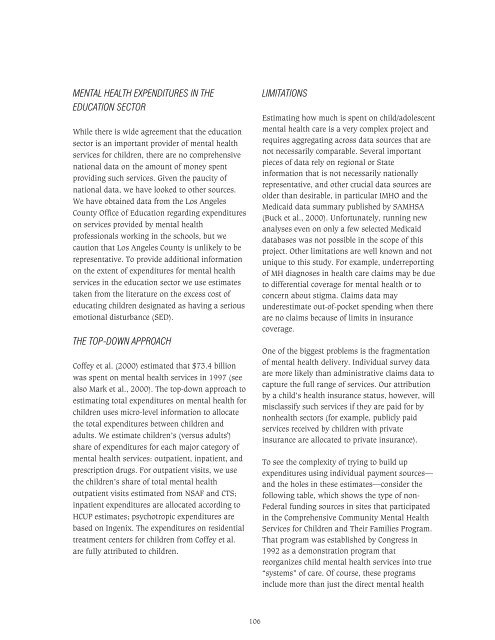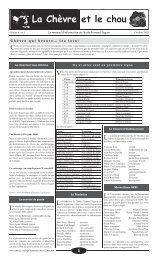Research on Child and Adolescent Mental Health
Research on Child and Adolescent Mental Health
Research on Child and Adolescent Mental Health
You also want an ePaper? Increase the reach of your titles
YUMPU automatically turns print PDFs into web optimized ePapers that Google loves.
MENTAL HEALTH EXPENDITURES IN THE<br />
EDUCATION SECTOR<br />
While there is wide agreement that the educati<strong>on</strong><br />
sector is an important provider of mental health<br />
services for children, there are no comprehensive<br />
nati<strong>on</strong>al data <strong>on</strong> the amount of m<strong>on</strong>ey spent<br />
providing such services. Given the paucity of<br />
nati<strong>on</strong>al data, we have looked to other sources.<br />
We have obtained data from the Los Angeles<br />
County Office of Educati<strong>on</strong> regarding expenditures<br />
<strong>on</strong> services provided by mental health<br />
professi<strong>on</strong>als working in the schools, but we<br />
cauti<strong>on</strong> that Los Angeles County is unlikely to be<br />
representative. To provide additi<strong>on</strong>al informati<strong>on</strong><br />
<strong>on</strong> the extent of expenditures for mental health<br />
services in the educati<strong>on</strong> sector we use estimates<br />
taken from the literature <strong>on</strong> the excess cost of<br />
educating children designated as having a serious<br />
emoti<strong>on</strong>al disturbance (SED).<br />
THE TOP-DOWN APPROACH<br />
Coffey et al. (2000) estimated that $73.4 billi<strong>on</strong><br />
was spent <strong>on</strong> mental health services in 1997 (see<br />
also Mark et al., 2000). The top-down approach to<br />
estimating total expenditures <strong>on</strong> mental health for<br />
children uses micro-level informati<strong>on</strong> to allocate<br />
the total expenditures between children <strong>and</strong><br />
adults. We estimate children’s (versus adults')<br />
share of expenditures for each major category of<br />
mental health services: outpatient, inpatient, <strong>and</strong><br />
prescripti<strong>on</strong> drugs. For outpatient visits, we use<br />
the children’s share of total mental health<br />
outpatient visits estimated from NSAF <strong>and</strong> CTS;<br />
inpatient expenditures are allocated according to<br />
HCUP estimates; psychotropic expenditures are<br />
based <strong>on</strong> Ingenix. The expenditures <strong>on</strong> residential<br />
treatment centers for children from Coffey et al.<br />
are fully attributed to children.<br />
LIMITATIONS<br />
Estimating how much is spent <strong>on</strong> child/adolescent<br />
mental health care is a very complex project <strong>and</strong><br />
requires aggregating across data sources that are<br />
not necessarily comparable. Several important<br />
pieces of data rely <strong>on</strong> regi<strong>on</strong>al or State<br />
informati<strong>on</strong> that is not necessarily nati<strong>on</strong>ally<br />
representative, <strong>and</strong> other crucial data sources are<br />
older than desirable, in particular IMHO <strong>and</strong> the<br />
Medicaid data summary published by SAMHSA<br />
(Buck et al., 2000). Unfortunately, running new<br />
analyses even <strong>on</strong> <strong>on</strong>ly a few selected Medicaid<br />
databases was not possible in the scope of this<br />
project. Other limitati<strong>on</strong>s are well known <strong>and</strong> not<br />
unique to this study. For example, underreporting<br />
of MH diagnoses in health care claims may be due<br />
to differential coverage for mental health or to<br />
c<strong>on</strong>cern about stigma. Claims data may<br />
underestimate out-of-pocket spending when there<br />
are no claims because of limits in insurance<br />
coverage.<br />
One of the biggest problems is the fragmentati<strong>on</strong><br />
of mental health delivery. Individual survey data<br />
are more likely than administrative claims data to<br />
capture the full range of services. Our attributi<strong>on</strong><br />
by a child’s health insurance status, however, will<br />
misclassify such services if they are paid for by<br />
n<strong>on</strong>health sectors (for example, publicly paid<br />
services received by children with private<br />
insurance are allocated to private insurance).<br />
To see the complexity of trying to build up<br />
expenditures using individual payment sources—<br />
<strong>and</strong> the holes in these estimates—c<strong>on</strong>sider the<br />
following table, which shows the type of n<strong>on</strong>-<br />
Federal funding sources in sites that participated<br />
in the Comprehensive Community <strong>Mental</strong> <strong>Health</strong><br />
Services for <strong>Child</strong>ren <strong>and</strong> Their Families Program.<br />
That program was established by C<strong>on</strong>gress in<br />
1992 as a dem<strong>on</strong>strati<strong>on</strong> program that<br />
reorganizes child mental health services into true<br />
“systems” of care. Of course, these programs<br />
include more than just the direct mental health<br />
106

















